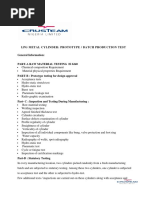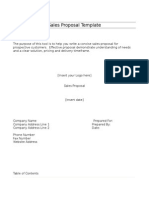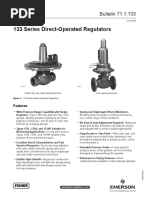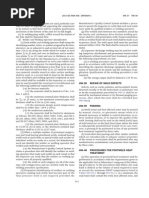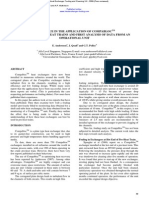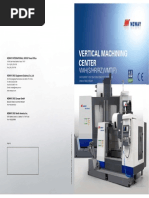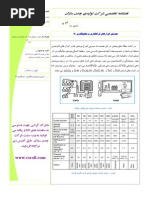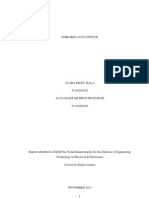0 ratings0% found this document useful (0 votes)
363 viewsSecVIII Div1 UW40
SecVIII Div1 UW40
Uploaded by
arianaseriThis document provides guidelines for welding procedures and post-weld heat treatment. It specifies that welds must have complete penetration and fusion. It requires welder identification on welds over a certain thickness. It allows various methods for post-weld heat treatment including heating the entire vessel, sections of a vessel, or localized areas using internal or external heating to achieve proper temperatures and soak times.
Copyright:
© All Rights Reserved
Available Formats
Download as PDF, TXT or read online from Scribd
SecVIII Div1 UW40
SecVIII Div1 UW40
Uploaded by
arianaseri0 ratings0% found this document useful (0 votes)
363 views2 pagesThis document provides guidelines for welding procedures and post-weld heat treatment. It specifies that welds must have complete penetration and fusion. It requires welder identification on welds over a certain thickness. It allows various methods for post-weld heat treatment including heating the entire vessel, sections of a vessel, or localized areas using internal or external heating to achieve proper temperatures and soak times.
Original Description:
SecVIII-Div1-UW40
Original Title
SecVIII-Div1-UW40
Copyright
© © All Rights Reserved
Available Formats
PDF, TXT or read online from Scribd
Share this document
Did you find this document useful?
Is this content inappropriate?
This document provides guidelines for welding procedures and post-weld heat treatment. It specifies that welds must have complete penetration and fusion. It requires welder identification on welds over a certain thickness. It allows various methods for post-weld heat treatment including heating the entire vessel, sections of a vessel, or localized areas using internal or external heating to achieve proper temperatures and soak times.
Copyright:
© All Rights Reserved
Available Formats
Download as PDF, TXT or read online from Scribd
Download as pdf or txt
0 ratings0% found this document useful (0 votes)
363 views2 pagesSecVIII Div1 UW40
SecVIII Div1 UW40
Uploaded by
arianaseriThis document provides guidelines for welding procedures and post-weld heat treatment. It specifies that welds must have complete penetration and fusion. It requires welder identification on welds over a certain thickness. It allows various methods for post-weld heat treatment including heating the entire vessel, sections of a vessel, or localized areas using internal or external heating to achieve proper temperatures and soak times.
Copyright:
© All Rights Reserved
Available Formats
Download as PDF, TXT or read online from Scribd
Download as pdf or txt
You are on page 1of 2
(d) Where singlewelded joints are used, particular care
shall be taken in aligning and separating the components
to be joined so that there will be complete penetration
and fusion at the bottom of the joint for its full length.
(e) In welding plug welds, a fillet around the bottom of
the hole shall be deposited first.
(f) Welder and Welding Operator Identification
(1) Each welder and welding operator shall stamp the
identifying number, letter, or symbol assigned by the Man-
ufacturer, on or adjacent to and at intervals of not more
than 3 ft (1 m) along the welds which he makes in steel
plates
1
/
4
in. (6 mm) and over in thickness and in nonfer-
rous plates
1
/
2
in. (13 mm) and over in thickness; or a re-
cord shall be kept by the Manufacturer of welders and
welding operators employed on each joint which shall
be available to the Inspector. For identifying welds on ves-
sels in which the wall thickness is less than
1
/
4
in. (6 mm)
for steel material and less than
1
/
2
in. (13 mm) for nonfer-
rous material, suitable stencil or other surface markings
shall be used; or a record shall be kept by the Manufac-
turer of welders and welding operators employed on each
joint which shall be available to the Inspector; or a stamp
may be used provided the vessel part is not deformed and
the following additional requirements are met:
(-a) for ferrous materials:
(-1) the materials shall be limited to PNo. 1 Gr.
Nos. 1 and 2;
(-2) the minimum nominal plate thickness shall
be
3
/
16
in. (5 mm), or the minimum nominal pipe wall
thickness shall be 0.154 in. (3.91 mm);
(-3) the minimum design metal temperature
shall be no colder than 20F (29C);
(-b) for nonferrous materials:
(-1) the materials shall be limited to aluminum
as follows: SB-209 Alloys 3003, 5083, 5454, and 6061;
SB-241 Alloys 3003, 5083, 5086, 5454, 6061, and 6063;
and SB-247 Alloys 3003, 5083, and 6061;
(-2) the minimum nominal plate thickness shall
be 0.249 in. (6.32 mm), or the minimum nominal pipe
thickness shall be 0.133 in. (3.37 mm).
(2) When a multiple number of permanent nonpres-
sure part load bearing attachment welds, nonloadbearing
welds such as stud welds, or special welds such as tubeto
tubesheet welds are made on a vessel, the Manufacturer
need not identify the welder or welding operator that
welded each individual joint provided:
(-a) the Manufacturers Quality Control System in-
cludes a procedure that will identify the welders or weld-
ing operators that made such welds on each vessel so that
the Inspector can verify that the welders or welding op-
erators were all properly qualified;
(-b) the welds in each category are all of the same
type and configuration and are welded with the same
welding procedure specification.
(3) Permanent identification of welders or welding
operators making tack welds that become part of the
fi nal pressure wel d i s not requi red provi ded the
Manufacturers Quality Control System includes a proce-
dure to permit the Inspector to verify that such tack welds
were made by qualified welders or welding operators.
(g) The welded joint between two members joined by
the inertia and continuous drive friction welding pro-
cesses shall be a full penetration weld. Visual examination
of the aswelded flash roll of each weld shall be made as an
in-process check. The weld upset shall meet the specified
amount within 10%. The flash shall be removed to sound
metal.
(h) Capacitor discharge welding may be used for weld-
ing temporary attachments and permanent nonstructural
attachments without postweld heat treatment, provided
the following requirements are met:
(1) A welding procedure specification shall be pre-
pared in accordance with Section IX, insofar as possible
describing the capacitor discharge equipment, the combi-
nation of materials to be joined, and the technique of ap-
plication. Qualification of the welding procedure is not
required.
(2) The energy output shall be limited to 125 Wsec.
UW-38 REPAIR OF WELD DEFECTS
Defects, such as cracks, pinholes, and incomplete fusion,
detected visually or by the hydrostatic or pneumatic test
or by the examinations prescribed in UW-11 shall be re-
moved by mechanical means or by thermal gouging pro-
cesses, after which the joint shall be rewelded [see
UW-40(e)].
UW-39 PEENING
(a) Weld metal and heat affected zones may be peened
by manual, electric, or pneumatic means when it is
deemed necessary or helpful to control distortion, to re-
lieve residual stresses, or to improve the quality of the
weld. Peening shall not be used on the initial (root) layer
of weld metal nor on the final (face) layer unless the weld
is subsequently postweld heat treated. In no case, how-
ever, is peening to be performed in lieu of any postweld
heat treatment required by these rules.
(b) Controlled shot peening and other similar methods
which are intended only to enhance surface properties
of the vessel or vessel parts shall be performed after any
nondestructive examinations and pressure tests required
by these rules.
UW-40 PROCEDURES FOR POSTWELD HEAT
TREATMENT
(a) The operation of postweld heat treatment shall be
performed in accordance with the requirements given in
the applicable Part in Subsection C using one of the follow-
ing procedures. In the procedures that follow, the soak
band is defined as the volume of metal required to meet
or exceed the minimum PWHT temperatures listed in
Tables UCS-56-1 through UCS-56-11. As a minimum, the
soak band shall contain the weld, heat affected zone, and
2013 SECTION VIII - DIVISION 1 UW-37 UW-40
143
a portion of base metal adjacent to the weld being heat
treated. The minimum width of this volume is the widest
width of weld plus 1t or 2 in. (50 mm), whichever is less,
on each side or end of the weld. The term t is the nominal
thickness as defined in (f) below. For additional detailed
recommendations regarding implementation and perfor-
mance of these procedures, refer to Welding Research
Council (WRC) Bulletin 452, June 2000, Recommended
Practices for Local Heating of Welds in Pressure Vessels.
(1) heating the vessel as a whole in an enclosed fur-
nace. This procedure is preferable and should be used
whenever practicable.
(2) heating the vessel in more than one heat in a fur-
nace, provided the overlap of the heated sections of the
vessel is at least 5 ft (1.5 m). When this procedure is used,
the portion outside of the furnace shall be shielded so that
the temperature gradient is not harmful. The cross section
where the vessel projects from the furnace shall not inter-
sect a nozzle or other structural discontinuity.
(3) heating of shell sections and/or portions of ves-
sels to postweld heat treat longitudinal joints or compli-
cated wel ded detai l s before j oi ni ng to make the
completed vessel. When the vessel is required to be post-
weld heat treated, and it is not practicable to postweld
heat treat the completed vessel as a whole or in two or
more heats as provided in (2) above, any circumferential
joints not previously postweld heat treated may be there-
after locally postweld heat treated by heating such joints
by any appropriate means that will assure the required
uniformity. For such local heating, the soak band shall ex-
tend around the full circumference. The portion outside
the soak band shall be protected so that the temperature
gradient is not harmful. This procedure may also be used
to postweld heat treat portions of new vessels after
repairs.
(4) heating the vessel internally by any appropriate
means and with adequate indicating and recording tem-
perature devices to aid in the control and maintenance
of a uniform distribution of temperature in the vessel wall.
Previous to this operation, the vessel should be fully en-
closed with insulating material, or the permanent insula-
tion may be installed provided it is suitable for the
required temperature. In this procedure the internal pres-
sure should be kept as low as practicable, but shall not ex-
ceed 50% of the maximum allowable working pressure at
the highest metal temperature expected during the post-
weld heat treatment period.
(5) heating a circumferential band containing nozzles
or other welded attachments that require postweld heat
treatment in such a manner that the entire band shall be
brought up uniformly to the required temperature and
held for the specified time. Except as modified in this para-
graph below, the soak band shall extend around the entire
vessel, and shall include the nozzle or welded attachment.
The circumferential soak band width may be varied away
from the nozzle or attachment weld requiring PWHT, pro-
vided the required soak band around the nozzle or
attachment weld is heated to the required temperature
and held for the required time. As an alternative to varying
the soak band width, the temperature within the circum-
ferential band away from the nozzle or attachment may
be varied and need not reach the required temperature,
provided the required soak band around the nozzle or at-
tachment weld is heated to the required temperature, held
for the required time, and the temperature gradient is not
harmful throughout the heating and cooling cycle. The
portion of the vessel outside of the circumferential soak
band shall be protected so that the temperature gradient
is not harmful. This procedure may also be used to post-
weld heat treat portions of vessels after repairs.
(6) heating the circumferential joints of pipe or tub-
ing by any appropriate means using a soak band that ex-
tends around the entire circumference. The portion
outside the soak band shall be protected so that the tem-
perature gradient is not harmful. The proximity to the
shell increases thermal restraint, and the designer should
provide adequate length to permit heat treatment without
harmful gradients at the nozzle attachment or heat a full
circumferential band around the shell, including the
nozzle.
(7) heating a local area around nozzles or welded at-
tachments in the larger radius sections of a double curva-
ture head or a spherical shell or head in such a manner
that the area is brought up uniformly to the required tem-
perature and held for the specified time. The soak band
shall include the nozzle or welded attachment. The soak
band shall include a circle that extends beyond the edges
of the attachment weld in all directions by a minimum of t
or 2 in. (50 mm), whichever is less. The portion of the ves-
sel outside of the soak band shall be protected so that the
temperature gradient is not harmful.
(8) heating of other configurations. Local area heating
of other configurations such as spots or bulls eye local
heating not addressed in (a)(1) through (a)(7) above is
permitted, provided that other measures (based upon suf-
ficiently similar, documented experience or evaluation)
are taken that consider the effect of thermal gradients,
all significant structural discontinuities (such as nozzles,
attachments, head to shell junctures), and any mechanical
loads which may be present during PWHT. The portion of
the vessel or component outside the soak band shall be
protected so that the temperature gradient is not harmful.
(b) The temperatures and rates of heating and cooling
to be used in postweld heat treatment of vessels con-
structed of materials for which postweld heat treatment
may be required are given in UCS-56, UHT-56, UNF-56,
and UHA-32.
(c) The minimum temperature for postweld heat treat-
ment given in Tables UCS-56-1 through UCS-56-11,
Table UHT-56, and Tables UHA-32-1 through UHA-32-6,
and in UNF-56, shall be the minimum temperature of the
plate material of the shell or head of any vessel. Where
more than one pressure vessel or pressure vessel part
are postwel d heat treated in one furnace charge,
2013 SECTION VIII - DIVISION 1 UW-40
144
You might also like
- SB-165 - ASME BPVC 2021 Sección II Part BDocument6 pagesSB-165 - ASME BPVC 2021 Sección II Part BMohammad TaherNo ratings yet
- Engine Mechanical (4Hk1, 6Hk1) 1A-7: CautionDocument1 pageEngine Mechanical (4Hk1, 6Hk1) 1A-7: CautionВладимир ШведNo ratings yet
- LPG Metal CylinderDocument20 pagesLPG Metal Cylinderorode franklynNo ratings yet
- Presentation: Failure of Bleeder ValveDocument13 pagesPresentation: Failure of Bleeder Valvekselvan_1No ratings yet
- Sales Proposal Sales Proposal Template 1.doctemplate 1Document5 pagesSales Proposal Sales Proposal Template 1.doctemplate 1arianaseriNo ratings yet
- Ecomat Opertors ManualDocument36 pagesEcomat Opertors Manualryanswj50% (2)
- Tyco Valves & Controls CatalogDocument6 pagesTyco Valves & Controls CatalogHasanNo ratings yet
- Table 2-2.1 Pressure-Temperature Ratings For Group 2.1 MaterialsDocument1 pageTable 2-2.1 Pressure-Temperature Ratings For Group 2.1 MaterialsPanchal Shailesh100% (1)
- WHRB-265!08!00 Front and Rear Mirrors, Shell CalculationDocument2 pagesWHRB-265!08!00 Front and Rear Mirrors, Shell CalculationmehmacarNo ratings yet
- Asme B31 - Pressure PipingDocument3 pagesAsme B31 - Pressure PipingAndhyka Cakrabuana AdhitamaNo ratings yet
- 2003 ASME B31.3-For 570Document41 pages2003 ASME B31.3-For 570sheikbba100% (2)
- C2quick PDFDocument34 pagesC2quick PDFJose Maria PedrazasNo ratings yet
- ASME I Part PMB Requirements For Miniature BoilersDocument2 pagesASME I Part PMB Requirements For Miniature BoilersAmanda Ariesta ApriliaNo ratings yet
- Sec. II A - SA - 209Document6 pagesSec. II A - SA - 209RamuAlagappanNo ratings yet
- ES - BlowOut User ManualDocument11 pagesES - BlowOut User Manualleekiangyen79No ratings yet
- 4000 Series Cryogenic Valve: Bulletin 86.1:4000Document8 pages4000 Series Cryogenic Valve: Bulletin 86.1:4000Datt NguyenNo ratings yet
- BAC FB Ball Valves Carbon Steel Stainless Steel Full Bore ANSI Class 150Document1 pageBAC FB Ball Valves Carbon Steel Stainless Steel Full Bore ANSI Class 150ChristianNo ratings yet
- Niwatec Presentation EnglDocument27 pagesNiwatec Presentation EnglmohamedwalyNo ratings yet
- ASME Section V, VI, VIII, IIDocument1 pageASME Section V, VI, VIII, IIGNPeru100% (1)
- 133 Series Direct-Operated Regulators: Bulletin 71.1:133Document24 pages133 Series Direct-Operated Regulators: Bulletin 71.1:133JuliusMaximus12No ratings yet
- Is 7291 1981 PDFDocument38 pagesIs 7291 1981 PDFAnubhav LakhmaniNo ratings yet
- Hydrant Flow Test Report: Private Fire Service MainsDocument1 pageHydrant Flow Test Report: Private Fire Service MainsTaslimah AliNo ratings yet
- 39CQ Iom 06302014Document20 pages39CQ Iom 06302014Non Etabas GadnatamNo ratings yet
- HT BucefaDocument2 pagesHT Bucefarafa100% (1)
- Covalence HTLP80: Product Data SheetDocument3 pagesCovalence HTLP80: Product Data SheetJuan Carlos Contreras CherresNo ratings yet
- Barlow's FormulaDocument2 pagesBarlow's FormularsproservNo ratings yet
- Series 4030: Base Mounted Pump Installation and Operating InstructionsDocument8 pagesSeries 4030: Base Mounted Pump Installation and Operating InstructionsrakeshamechNo ratings yet
- HT Cabezal NeumaticoDocument2 pagesHT Cabezal NeumaticorafaNo ratings yet
- Onshore Program Construction & Installation Contract (OPCIC) Enabling AgreementDocument158 pagesOnshore Program Construction & Installation Contract (OPCIC) Enabling Agreementbrook emenikeNo ratings yet
- 02 Mech-OS&Y Gate Valve UL FM (XZ41X VALVULAS 290917Document1 page02 Mech-OS&Y Gate Valve UL FM (XZ41X VALVULAS 290917Roman Ugarte0% (1)
- NI-0253 - J Pressure Vessel DesignDocument45 pagesNI-0253 - J Pressure Vessel DesignsudokuNo ratings yet
- Fire Hydrant Valve Bs 5041: SpecificationDocument2 pagesFire Hydrant Valve Bs 5041: Specificationirrosel4650No ratings yet
- Hot Tapping: What Does The Procedure Say?: We Can Work Under PressureDocument59 pagesHot Tapping: What Does The Procedure Say?: We Can Work Under PressureHerberth SilitongaNo ratings yet
- Tyco Fig.110-190 Ball Valves DatasheetDocument24 pagesTyco Fig.110-190 Ball Valves DatasheetMahdi Daly100% (1)
- Trav L Cutter ManualDocument46 pagesTrav L Cutter ManualullwnNo ratings yet
- Iso 21013-4 2012 EnglishDocument16 pagesIso 21013-4 2012 EnglishLuis SuarezNo ratings yet
- P17-1TS-KBR Bolting Types Carbon & Alloy SteelDocument2 pagesP17-1TS-KBR Bolting Types Carbon & Alloy Steelyulianus_sr100% (1)
- Calculation Standards For Safety Relief ValvesDocument2 pagesCalculation Standards For Safety Relief ValvesJulio SaldanhaNo ratings yet
- Guiding Principles Assessment AssembliesDocument10 pagesGuiding Principles Assessment AssembliesGiannis ApostolouNo ratings yet
- Autodesk Feature CodesDocument14 pagesAutodesk Feature Codessplaw9484No ratings yet
- StandardsDocument26 pagesStandardsshahin TamouzadehNo ratings yet
- Nema SM-23Document3 pagesNema SM-23Vishal KandNo ratings yet
- Scaffolding Estimation SampleDocument2 pagesScaffolding Estimation Samplejhomel garciaNo ratings yet
- Data Sheet S7 - 2020 - ENG - Light - CavagnaDocument12 pagesData Sheet S7 - 2020 - ENG - Light - CavagnaWND PRTMNo ratings yet
- Crane Fluid Flow Problems Hof MasterDocument280 pagesCrane Fluid Flow Problems Hof MasterMohammad Mehdi JafariNo ratings yet
- Sihi Pompa LPG API 610Document1 pageSihi Pompa LPG API 610Andry RimanovNo ratings yet
- RASCO CatalogDocument17 pagesRASCO Catalogdesters1120No ratings yet
- BS en 10028-5-2009Document19 pagesBS en 10028-5-2009anupsharma2522_98756No ratings yet
- AEL6 Series Smart Electric Linear Actuators For DN15 To DN100 Control Valves-Installation Maintenance ManualDocument28 pagesAEL6 Series Smart Electric Linear Actuators For DN15 To DN100 Control Valves-Installation Maintenance ManualNguyen Xuan QuangNo ratings yet
- Api 510 Open 1Document4 pagesApi 510 Open 1melvinNo ratings yet
- BS EN 837-1:1998 Pressure Gauges. Bourdon Tube Pressure Gauge - Part 1: Dimensions Metrology Requirements and TestingDocument3 pagesBS EN 837-1:1998 Pressure Gauges. Bourdon Tube Pressure Gauge - Part 1: Dimensions Metrology Requirements and TestingСергей Парахин0% (1)
- METHOD STATEMENT FOR PIPING REV 01 16 June 2021Document20 pagesMETHOD STATEMENT FOR PIPING REV 01 16 June 2021Moh'd SameerNo ratings yet
- Appendix 41 PDFDocument5 pagesAppendix 41 PDFHanafi BasriNo ratings yet
- En10028 2Document12 pagesEn10028 2Patilea Daniela100% (1)
- Folder Grobblech Heads Cones 1608Document28 pagesFolder Grobblech Heads Cones 1608Filip StojkovskiNo ratings yet
- Nr13 em InglêsDocument16 pagesNr13 em InglêsmafepiNo ratings yet
- ISO 03545-1-1989 ScanDocument7 pagesISO 03545-1-1989 ScanDejan AntanasijevicNo ratings yet
- Asme 1325-18 (2007)Document1 pageAsme 1325-18 (2007)Matthew TaylorNo ratings yet
- CSI Bolt-On Heating SystemsDocument12 pagesCSI Bolt-On Heating Systemspeubrandao100% (1)
- Deaerators BrochureDocument4 pagesDeaerators BrochurefahimshkNo ratings yet
- Post Welded Heat Treatment ProceduresDocument3 pagesPost Welded Heat Treatment Proceduresradhakrishnan100% (1)
- 4 Heat TreatmentokDocument22 pages4 Heat TreatmentokPramod Athiyarathu100% (1)
- PWHT Procedure For Petrol Steel - CoreDocument9 pagesPWHT Procedure For Petrol Steel - CoreSuleyman HaliciogluNo ratings yet
- 1.vendor List - Rev.6Document174 pages1.vendor List - Rev.6arianaseri100% (2)
- Data Sheet - UMEB - IP55Document2 pagesData Sheet - UMEB - IP55arianaseriNo ratings yet
- 6 Polley Compabloc FDocument5 pages6 Polley Compabloc FarianaseriNo ratings yet
- Ni-Base Superalloy 718 (VIM+VAR) : Z Equivalent SpecificationDocument2 pagesNi-Base Superalloy 718 (VIM+VAR) : Z Equivalent SpecificationarianaseriNo ratings yet
- Neway International Group Head Office: CNC Equipment (Suzhou) Co.,LtdDocument18 pagesNeway International Group Head Office: CNC Equipment (Suzhou) Co.,LtdarianaseriNo ratings yet
- 5S Checklist ReaderDocument1 page5S Checklist ReaderarianaseriNo ratings yet
- OG Brochure - Alloys InsertDocument2 pagesOG Brochure - Alloys InsertarianaseriNo ratings yet
- Ma30 WDocument2 pagesMa30 WarianaseriNo ratings yet
- لکش 1 یهد ششوپ کیتامش شیامن CVD و PVDDocument5 pagesلکش 1 یهد ششوپ کیتامش شیامن CVD و PVDarianaseriNo ratings yet
- High Perf Metals Brochure v1Document5 pagesHigh Perf Metals Brochure v1arianaseriNo ratings yet
- Training Session4 - Heat Recovery Steam GeneratorsDocument34 pagesTraining Session4 - Heat Recovery Steam Generatorsarianaseri100% (1)
- Grooved Kempchen PDFDocument11 pagesGrooved Kempchen PDFAnonymous Iev5ggSRNo ratings yet
- CPDocument55 pagesCParianaseri100% (2)
- Experimental Determination of Fouling Factor On Plate Heat Exchangers in District Heating System PDFDocument8 pagesExperimental Determination of Fouling Factor On Plate Heat Exchangers in District Heating System PDFarianaseriNo ratings yet
- PLATE & SHELL Heat Exchangers: A Shell & Tube AlternativeDocument4 pagesPLATE & SHELL Heat Exchangers: A Shell & Tube AlternativearianaseriNo ratings yet
- Grade 10 CVDocument9 pagesGrade 10 CVMutangeni ShikondaNo ratings yet
- Ip Dcr600v15aDocument1 pageIp Dcr600v15amohasshozif1988100% (1)
- Department of Electrical Engineering Measurement Devices (Dee 10013) EOC 1 (B) SESI 1 2021/2022Document2 pagesDepartment of Electrical Engineering Measurement Devices (Dee 10013) EOC 1 (B) SESI 1 2021/2022Arif FahmiNo ratings yet
- Quality Procedures Manual: Quality Management System DocumentationDocument4 pagesQuality Procedures Manual: Quality Management System DocumentationMarianne Lou PalomarNo ratings yet
- Mca Syllabus FinalDocument127 pagesMca Syllabus FinalJamil KhanNo ratings yet
- FR 51110209102Document76 pagesFR 51110209102Naveed Akbar Mughal0% (1)
- Cyber OSINT Coding Python Transforms For Maltego LibreDocument49 pagesCyber OSINT Coding Python Transforms For Maltego LibreDanisio PereiraNo ratings yet
- Decision Support Tools For Integrated Water Resources ManagementDocument18 pagesDecision Support Tools For Integrated Water Resources ManagementVitor Vieira VasconcelosNo ratings yet
- Haryana Government Gazette: Published by AuthorityDocument8 pagesHaryana Government Gazette: Published by AuthorityEr navneet jassiNo ratings yet
- Https Student - Nielit.gov - in CAND CertificateAdmitCardVersion4.aspx Qs ZQoIhiZ iYfsy3xrnnzcYGAlkhBae8+RDocument2 pagesHttps Student - Nielit.gov - in CAND CertificateAdmitCardVersion4.aspx Qs ZQoIhiZ iYfsy3xrnnzcYGAlkhBae8+RkushNo ratings yet
- Plantilla PowerPoint Del Sistema RespiratorioDocument33 pagesPlantilla PowerPoint Del Sistema RespiratorioYesenia CaloNo ratings yet
- Kmme Online Bip Presentation Template v2Document11 pagesKmme Online Bip Presentation Template v2ncsulatNo ratings yet
- Naca Corde Nombre de "Vagues"Document26 pagesNaca Corde Nombre de "Vagues"multiacNo ratings yet
- Inspection Test Plan (Itp) at Shop: Remark No DescriptionDocument2 pagesInspection Test Plan (Itp) at Shop: Remark No Descriptionanang_pri100% (1)
- High Temperature Mechanical TestingDocument6 pagesHigh Temperature Mechanical TestingSoupramanien KathirvelouNo ratings yet
- DataTables Dason - Admin Dashboard TemplateDocument4 pagesDataTables Dason - Admin Dashboard Templatesaqib zaidiNo ratings yet
- User'S Manual: On-Line 1K-3KVADocument29 pagesUser'S Manual: On-Line 1K-3KVAanasNo ratings yet
- Control SystemsDocument25 pagesControl Systemskakaka12No ratings yet
- Prospectus MastersDocument78 pagesProspectus MastersMuhammad Mohsin RazaNo ratings yet
- 11-Media CharacteristicsDocument47 pages11-Media CharacteristicsNehaReshi50% (4)
- NexansDocument64 pagesNexansKhalif ElnaddabNo ratings yet
- Northrop F-5EF Flight ManualDocument516 pagesNorthrop F-5EF Flight ManualJose Pascual100% (4)
- Rec TubDocument1 pageRec TubEng Abdikarim WalhadNo ratings yet
- Key Features: ESM 390/395/400/405/410SDocument2 pagesKey Features: ESM 390/395/400/405/410SMulcue ProfeNo ratings yet
- Process Manual PMKVY-TI Dec 2016Document21 pagesProcess Manual PMKVY-TI Dec 2016Nikhil DeshmukhNo ratings yet
- River Training Works and Bank ProtectionDocument24 pagesRiver Training Works and Bank ProtectionAbdi GudetaNo ratings yet
- Ge Safetyswitch Tgnthirtythreetwentytwor SpecsDocument2 pagesGe Safetyswitch Tgnthirtythreetwentytwor SpecsIng. Mario A. Samudio IbarraNo ratings yet


